Content marketing and SEO are like peanut butter and jelly. You can eat them on their own, and they are delicious…
But what happens when you combine them? They complement each other, right? That’s why peanut butter and jelly sandwiches are so common…the flavors just go so well together.
The sandwich is so popular that you are likely to eat 2,500 of them by the time you are 18.
If you are trying to grow your qualified search traffic, you have to combine your content marketing with your SEO efforts. Running them as separate campaigns isn’t going to provide you with as big of a traffic increase as combining them into one campaign will.
And for you, large companies, this means you may have to restructure your organization so that content marketing and SEO are in one department.
Here are 7 smart ways to combine your content marketing with your SEO efforts:
Tactic #1: Create content that even Wikipedia would love to link to
One of the best sources of relevant traffic is Wikipedia. It ranks for almost every search term on Google, and it’s one of the most popular sites on the web.
We didn’t realize the power of Wikipedia until we listened in on a marketing presentation by Comedy Central. They were discussing how they grew their traffic, mentioning that Wikipedia is a key part of their traffic acquisition.
How much traffic are they generating from Wikipedia? Over 100,000 visitors a month! That’s insane!
What’s even more interesting is that they noticed that the pages with links from Wikipedia tend to generate more backlinks from other sites as well.
So, how can you get more links from Wikipedia? Well, the easiest way to do it is through Wikipedia broken-link building.
Wikipedia actually notes when links are dead as this gives editors a chance to find a replacement.
This is what you have to do to find these links in Google:
site:wikipedia.org insert keyword “dead link”
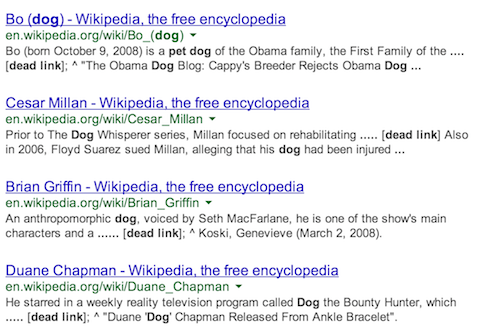
Next, click on a search result and find the phrase “dead link” on the page.
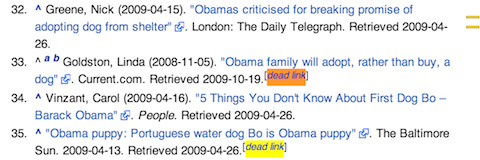
You can then take that URL, put it into Archive.org and create a similar page on your site, assuming it is related to your business and your visitors would find value in the content.
Once you have created a similar page, you can go back to the Wikipedia entry and click the “edit” button on the top right.
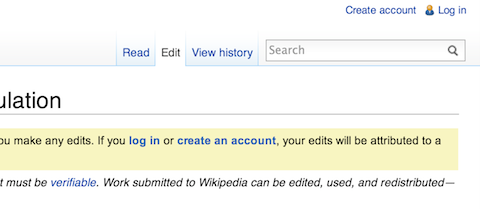
When editing, make sure you create a user account and edit other articles first. Wikipedia doesn’t want its users to just add links to their own sites. It wants its users to edit other entries as well and continue to provide value to the community.
If you want to get really advanced, take the URL of the broken link and place that URL into Ahrefs to get a full list of sites that are linking to the dead page. You can then hit each of them up, asking them to replace the dead link with the link to your site.
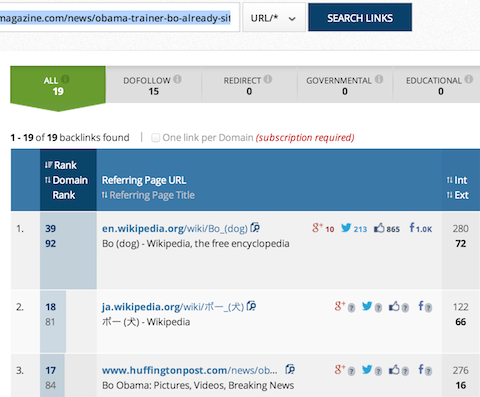
If you want to get the most out of this strategy, focus on creating pages that are highly relevant from a keyword and visitor perspective. It’s easy to get greedy with broken-link building, but the last thing you want to do is put up a hundred irrelevant pages just to get extra links.
Tactic #2: Write content based on keyword data
You shouldn’t be blogging for the sake of it. You should be blogging based on what your visitors want to read as well as what keywords you want to target.
It doesn’t matter that most of your search data is “not provided”. You can actually figure out what keywords are driving you traffic by using data from these 3 Google Analytics reports.

Once you have a list of keywords you are targeting, you can write content around them, assuming the topics also benefit your visitors.
We’ve used this strategy ourselves on Quick Sprout. Analytics showed that Instagram-related keywords produced sticky users, so we decided to write a blog post that discussed Instagram marketing.
Within 30 days of releasing the blog post, we started to rank for Instagram-related keywords, and our overall traffic went up by 120,000 visitors a month.
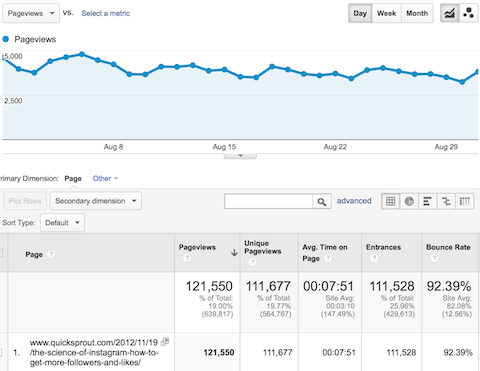
The key to obtaining large volumes of traffic successfully with this model is to cross-reference the keywords you are writing content on with Google Trends. For example, we will only write on topics that are trending up and to the right. If you write on topics that are dying down, you will see that those pages will continually get less and less traffic.

You won’t get these kind of results all the time, but if you use this tactic enough, you will see big wins.
Just make sure you don’t keyword-stuff when using this tactic as it will hurt your rankings.
Tactic #3: Create quality content before you aim for large quantities
When Google was in its infancy, you could throw up any kind of content and get thousands of visitors to your site. Eventually, they got smart, and their algorithm was able to figure out how to rank high quality content and not show low quality content.
For this reason, you should focus on writing high quality content that is in-depth. Why? Because an average content length for a web page that ranks on page 1 of Google is at least 2,000 words.

Moz also did an analysis to see if word count has a correlation with backlinks as the more backlinks a page has, the higher it typically ranks.
Here is a breakdown of the number of blog posts they have written based on word count:

And here is a breakdown of how many links those posts received:
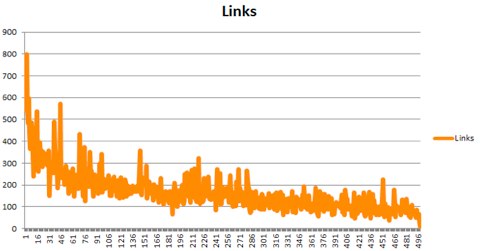
As you can see, there is a direct correlation between word count and the number of backlinks. For this reason, you should consider writing more in-depth articles as it will help increase your search engine rankings.
Plus, through Google’s In-depth Articles, you can increase your traffic by writing content that is more thorough. We were able to increase our search engine traffic by 13.15% by leveraging the in-depth articles update.
What we found is the increase came to pages that had an average word count of 2,183 words. Blog posts that were under 1,000 words didn’t see an increase in search traffic.
Once you are able to write detailed articles that are high in quality, you can then shift your focus to increasing the quantity. Till then, you should focus on writing more detailed content.
Tactic #4: Don’t forget about FAQs
By using Qualaroo or Survey Monkey you can figure out why your visitors aren’t converting into customers. All you have to do is ask them questions like:
- What else would you like to see on this page?
- Is there is a reason why you didn’t convert into a paying customer?
- What concerns do you have about the product or service?
By asking these and other questions, you can find all of the objections that are causing people to not convert. You can even ask your support team or dig through your support emails to figure out other objections your visitors have.
Once you have a list of concerns or questions your visitors have, consider creating an FAQ section that answers them. Doing this will help you start ranking for long-tail terms related to your product.
This won’t drive you a ton of traffic, but the traffic you do get will be highly relevant search traffic that converts. We use this exact strategy with our Crazy Egg support section, and we are able to drive an extra 4,108 visitors a month to our site. Roughly 82 of those visitors tend to convert into paying customers.
Tactic #5: Target industry blogs for guest-posting opportunities
The more links you have, the higher your rankings will be. By having your content marketing team target industry-related blogs, you will build relevant links that drive relevant traffic.
We’ve guest-posted 61 times on 49 different marketing blogs. In those guest posts, we’ve linked back to internal pages of Quick Sprout when relevant, and we never used rich anchor text. By doing this, we not only increased our referral traffic, but we also saw an uptick in search traffic.
Within 3 months of doing this, we saw an increase in search traffic by 22.7% for the articles we linked to.
If you want to increase your relevant traffic, you should consider the following:
- Guest-post on relevant sites only.
- Don’t try to manipulate search engines by linking to your site. Only link to your site when it benefits the readers.
- Avoid using rich anchor text.
In addition to following those rules, you should first read this post as it will teach you how to guest-post while staying within Google’s guidelines.
Tactic #6: Focus on indirect conversions
If you only focus your SEO efforts on driving traffic from keywords that convert, you’ll find yourself capping out on how much traffic you can get. By focusing on helping your ideal customers with their problems through your blog, you’ll get traffic from random search terms that are related to your industry, but don’t convert right away.
For example, at KISSmetrics, a ideal customer is an Internet marketer who has a business that does 10 million dollars or more in yearly revenue. Although we are only selling an analytics product, our customers are also spending their time and money on other marketing initiatives like SEO and social media marketing. So, on the KISSmetrics blog, we educate our visitors on topics like “how to steal your competitor’s social media followers”.
By doing this, we get additional 349,335 visitors from Google to our blog each month.
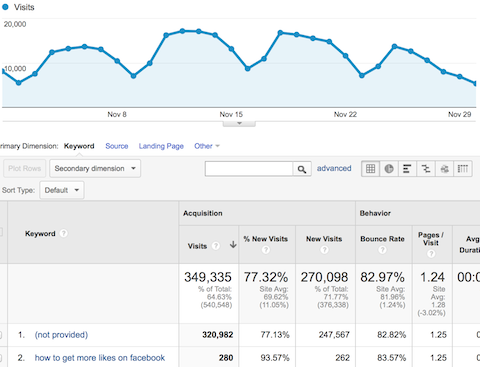
A lot of those visitors are marketers, and they typically don’t convert right away. Usually, after the 3rd visit, these blog readers decide to try out our KISSmetrics product because they like our content. This has allowed our blog to drive anywhere from 49% to 72% of our leads in any given month.
We aren’t the only ones experiencing this either. Moz also receives a large portion of its traffic from its blog content, which causes indirect conversions to its product.
Tactic #7: Don’t forget to cross-link
Adding content to your site isn’t enough. You have to cross-link your content. When we did consulting for blogs like TechCrunch, Mashable, and Gawker Media, we were able to increase their search traffic because we fixed their on-page issues.
The biggest one tended to be that pages weren’t cross-linked. When you have thousands of pages, and you eventually will, it’s impossible to create a site architecture that ensures all of your pages are indexed. This is why you have to cross-link your pages.
That’s exactly what we did for Mashable: we cross-linked its internal pages. Still to this date, Mashable uses that tactic, and it is the main reason why it ranks on page 1 of Google for terms like “Twitter”.
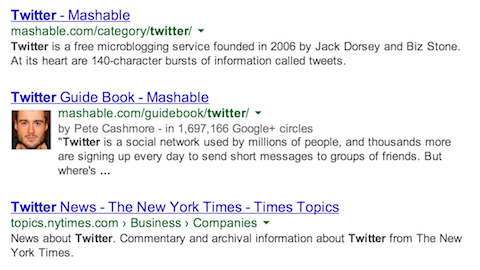
You too can get similar results as long as you cross-link your pages. Just be careful because if you make the links excessively rich in anchor text, it will hurt you. If Mashable internally linked to that Twitter page by only using the anchor text “Twitter” instead of using different texts for the link such as “click here”, it wouldn’t rank as high as it does now.
Conclusion
Although a good content marketer has a different skill set than a good SEO does, it doesn’t mean they should be working separately. By combining your content marketing efforts with your SEO efforts, you’ll find that you are able to increase your qualified search traffic at a faster pace.
Out of all the techniques mentioned above, our favorite one to leverage is the FAQ section. It’s not hard to do, and it can be used by all businesses.
